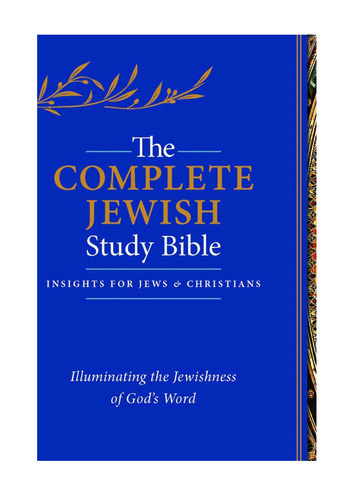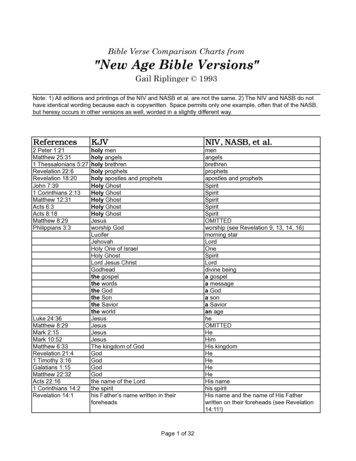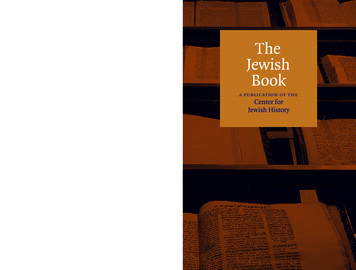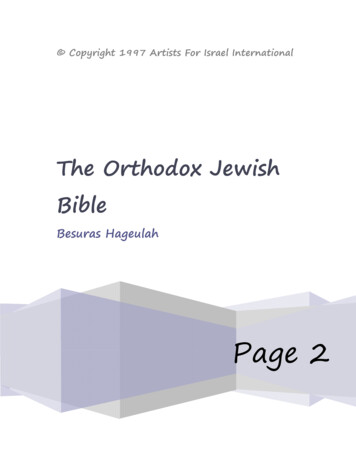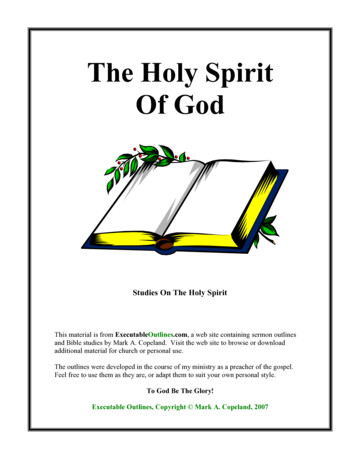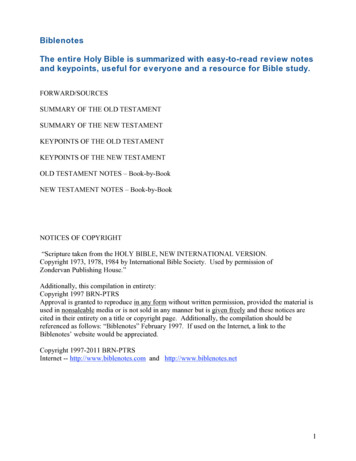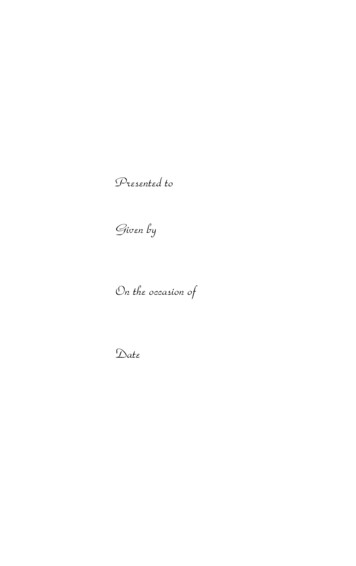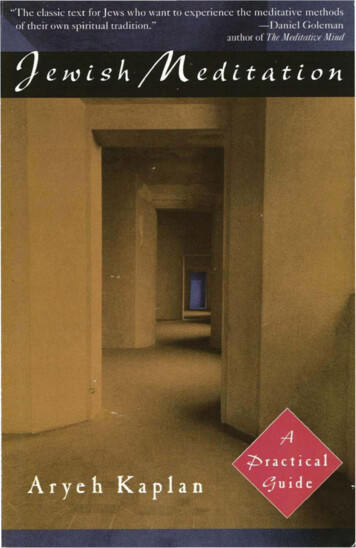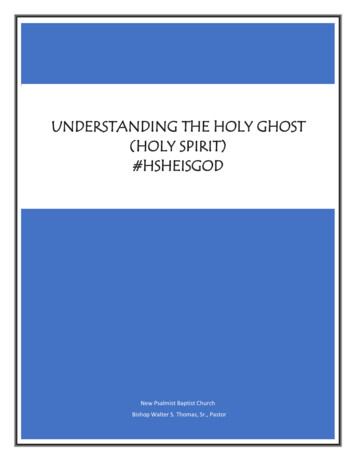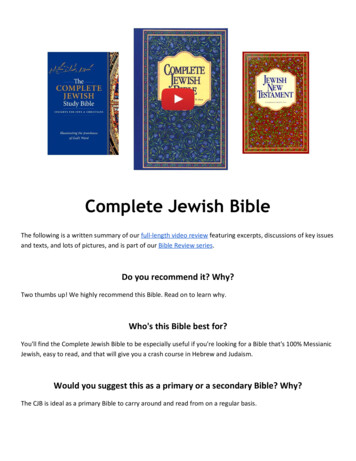
Transcription
Complete Jewish BibleThe following is a written summary of our full-length video review featuring excerpts, discussions of key issuesand texts, and lots of pictures, and is part of our Bible Review series .Do you recommend it? Why?Two thumbs up! We highly recommend this Bible. Read on to learn why.Who's this Bible best for?You'll find the Complete Jewish Bible to be especially useful if you're looking for a Bible that's 100% MessianicJewish, easy to read, and that will give you a crash course in Hebrew and Judaism.Would you suggest this as a primary or a secondary Bible? Why?The CJB is ideal as a primary Bible to carry around and read from on a regular basis.
How's this version's relationship with the Jews and Judaism?This Bible takes a very positive attitude towards the Jewish people, and towards Judaism. From its name as the"Complete Jewish B ible", to its overtly Jewish terminology and features, it "challenges both Jews andChristians to see that the whole Bible is Jewish", as is proclaimed in the introduction. (Watch the video reviewfor more from the intro.)The recently released Study Bible edition will be especially useful to Christians seeking to understand theJewish roots of their faith, and Jews seeking to better understand Messianic Judaism. More on that when wetalk about the "extras" in this Bible.The CJB was translated by a highly respected Messianic Jewish scholar. (More on him soon too!) Similarly, thecontributors to the notes and articles of the Study Bible edition read like a who's who of Messianic Judaism,featuring leading minds from the UMJC, MJAA, IAMCS, and Tikkun. The CJB not only emerged from theMessianic Jewish world, but is also significantly shaping it, and is widely used in Messianic Jewishcongregations. The simple act of reading from it is a celebration of the historic Messianic Jewish move of Godin our time!Who's the publisher and when did it come out?The pioneer Jewish New Testament first came out in 1989, followed by its companion JewishNew Testament Commentary i n 1992. Both were published by Lederer MessianicPublications.The groundbreaking Complete Jewish Bible was released, also by Lederer, to widespreadacclaim in 1998.And then in 2016 the Complete Jewish Study Bible was published, featuring an updatedtranslation enhanced with rich notes and a colourful new look, this time by Hendrickson Publishing and editedby Rabbi Barry Rubin.Who translated it and what's their story?Dr. David Stern is a highly respected scholar and pioneer in the MessianicJewish movement. He was born in 1935, came to faith in Yeshua in 1972, andmade aliyah (immigrated to Israel) with his wife Martha in 1979. In additionto the Complete Jewish Bible and Jewish New Testament commentary , Dr.Stern is also the author of the Messianic Jewish Manifesto, w hich was firstpublished in 1998 and then republished as Messianic Judaism: A ModernMovement with an Ancient Past i n 2007.
Dr. Stern holds degrees from Princeton University and Fuller TheologicalSeminary, taught at UCLA as a professor, and also taught Fuller's first'Judaism and Christianity' class. Speaking of Fuller! For a "fuller" bio, andto hear more of the story behind this translation, watch the videoreview .Is it more word for word or thought for thought?The New Testament (or Brit Hadashah as it's referred to throughout the Complete Jewish Bible) is Dr. Stern'stranslation direct from the Greek.The Tanach is his modern English paraphrase of the Jewish Publication Society's 1917 version, with somealterations based on the original Masoretic texts and comparisons with other translations.In both cases, the CJB makes for easy reading, and is more of a thought-for-thought "dynamic equivalent" thanit is a word-for-word "formal equivalent" translation.To hear Dr. Stern's own description of his methods of translation, and his explanation for why he simply callsthis a "version" rather than a paraphrase or translation, watch the video review .How are Hebrew personal names written?One of the distinctives of this version is how personalnames in both the Tanach and the New Testamentretain their original Hebrew pronunciation.Examples from the Tanach would include Avraham,Yitz'chak, and Ya'akov, Rivkah, Moshe, Y'hoshua,Avigayil, Shlomo, and Yesha'yahu.Examples from the Gospels would include Shimon Kefa,Ya'akov, Yochanan, Y'hudah, Miryam, Elisheva, andShoshanah. Of special note is Paul, who is alwaysreferred to by his Hebrew name Sha'ul, with theexception of Acts 13:9 which reads "then Sha'ul, alsoknown as Paul, filled with the Ruach HaKodesh ."
How are Hebrew place names written?Similarly, geographical names in both the Tanach and the New Testament retain their original Hebrewpronunciation. What's nifty is that this is what these places continue to be called in modern Hebrew in Israeltoday!Examples from the Tanach would include Yerushalayim, Hevron, Beit-Lechem, and Bavel.Examples from the Gospels would include the Galil, Natzeret, K'far Nachum, Beit-Anyah, Ramatayim, andShiloach.How are Hebrew book names written?The names of the books of the Tanach are written with their original Hebrew pronunciation, with theAnglicized versions of the book names in parentheses. For instance, B'resheet ( Genesis), Sh'mot ( Exodus),Tehillim ( Psalms), and Mishlei (Proverbs). If you're unsure how to pronounce these terms or don't understandtheir meanings but you'd like to learn, do Lesson 16 of Hebrew Quest .When the books of the New Testament are named after someone with aHebrew name - for instance, Mattityahu, Ya'akov, or Y'hudah - they'rewritten with the original Hebrew pronunciation of that name. Otherwisethey're generally written with their traditional designations - for instance,Romans or Philemon. Exceptions to this generality include Hebrews, whichis "Messianic Jews", and also to a lesser degree Acts and Revelation, whichare "the Acts of the Emissaries" and "the Revelation of Yeshua theMessiah", respectively.How are the names and titles of God written?In the Tanach, God's name is circumlocuted as "ADONAI", which literally means "my Master" or "my Lord". Foran in-depth discussion of the background to this tradition, and other related topics such as the history of thehybrid term Jehovah and the problem of how in the New Testament the Greek term Kurios can mean sir,Master, or ADONAI depending on context, watch the video review .Elohim is rendered as God, Adonai Yhwh as ADONAI God, Adonai as Adonai, El Shaddai as El Shaddai [GodAlmighty], El Elyon as El Elyon, El Kana as Jealous God, and Yhwh Tzvaot as Adonai Tzva'ot.In the Gospels, Iesous is rendered as Yeshua, Kurios as the Lord, and Christos as Messiah.The Holy Spirit is called the Ruach HaKodesh.
How are key terms in the Tanach rendered?Because this is a Jewish Bible that assumes you're either familiar with popular Hebrew words or up forlearning them, many of these key Hebrew words are transliterated rather than translated. Also, because this ismore of a paraphrase, original words aren't consistently translated into the same English word.With that disclaimer, acharit ha'yamim is phrased as acharit-hayamim, chag as festival, chesed a s grace orlove , chukah a s regulation, chukat olam as permanent regulation, emet as truth or faithfulness, emunah astrustworthy in Deuteronomy 32:4 and trusting faithfulness in Habakkuk 2:4; goyimas Goyim, hasatan as the Adversary, kadosh kadosh kadosh as "more holy than theholiest holiness" in Isaiah 6:3, kodeshim as the holy people, kodesh ha'kodeshim as"the Especially Holy Place", matzot as matzah, mikra kodesh as holy convocation,mishpat as just or rulings, mitzvah as mitzvah, mo'ed as seasons in Genesis 1:14 anddesignated times in Leviticus 23:2; pesach as Pesach, shabbaton as complete rest,sheol as the grave, sukkot as Sukkot, teruah as blasts of the shofar, torah istranslated as teaching, totafot as "at the front of a headband", tzedakah as right,tzitzit a s tzitzit, yom kippur as Yom-Kippur, and kippod a s hedgehog.How are key terms in the New Testament rendered?"Abide in me" is phrased as "stay united with me", Alpha and omega a s 'A' and 'Z' in the original, and 'Alef' and'Tav' in the updated text, antichrist as anti-Messiah, apostle as emissary, Baptist as Immerser, bind and looseas "prohibit and permit", baptizo as immerse, Christian as Messianic, cross as stake or execution-stake, crucifyas "nail up" or "put to death as a criminal", disciple as talmid, ekklesia as Community in Matthew 16:18,congregation in Matthew 18:17, and "Messianic community" in most other instances; ethnos a s Goyim inMatthew 5:47, pagans in Matthew 6:32, and Gentiles in Matthew 12:18; faith as "trusting faithfulness", feastof Dedication as Hanukkah , Jews as Judeans when referring to the Jews of that province, justify as "countrighteous", kraspidon as tzitzit, sect of the Nazarenes as "Natzratim" and Jesus the Nazarene as "Yeshua fromNatzeret", Pentecost as Shavu'ot , sanctify as "set apart for God", scribes as Torah scholars, phylacteries ast'fillin , paraclete as Counselor in John 14:16 and "who pleads our cause" in 1 John 2:1; peace as shalom , priestsas kohanim, propitiation as kapparah , righteous as tzaddik, Sabbath as Shabbat , and saints as holy people,God's people, or believers.Other Hebraisms germaine to this translation include common people as am ha'aretz, Barabbas as Bar-Abba,voice from heaven as bat kol, B oanerges as Bnei Regesh, blessing as brachah, circumcision as brit milah ,teaching as drash, paradise as Gen-Eden, h ymn in Matthew 26:30 as the Hallel, great day of the feast in John7:37 as Hoshana Rabbah, S ea of Galilee as Kinneret, b astard as mamzer , middle wall of partition as m'chitzah, lamp as menorah, washing as mikveh , hour of prayer as minchah, insane as meshugga , first day of the week inActs 20:7 and 1 Corinthians 16:2 as motza'ei Shabbat, ritual handwashing as n'tilat yadayim, world to come as
olam haba , Pharisees as P'rushim , New Moon as Rosh Hodesh, P assover meal as Seder, p eace to you as shalomaleikhem , question as sh'eilah , God's presence or glory as Sh'khinah, authority as s'mikhah , Scriptures asTanakh , Saducees as Tz'dukim, and jubilee as yovel. Scared to read the CJB out loud because you don't know how to say these Hebrew words right? Learn how inpart two of the video review .How are key verses in the New Testament interpreted?Watch part two of the video review for an in-depth discussion on how the writings of Paul regarding the Torahare interpreted, and to hear how some of the most popular verses in the New Testament are phrased.Is this the Tanach, the New Testament, or both?The Complete Jewish Bible and the Complete Jewish Study Bible feature both the Tanach and the NewTestament. Notably, there are no "Old Testament" and "New Testament" pages. Watch the video review tolearn why.As for the Jewish New Testament, it features only the New Testament - surprise!Does it also have the Hebrew text?This is a translation only, and doesn't include the original Hebrew text - although with the number oftransliterated Hebrew words you might forget if you're reading Hebrew or English.Does it open from right to left, or from left to right?The CJB opens and reads from left to right, like a regular English book.Are the books in the Jewish or Christian order?The books are in the traditional Jewish order, as are the chapters and verses. Watch the video review for adetailed explanation of the differences between Jewish and Christian Bibles.
How's the general layout and navigability?The layout in the Complete Jewish Bible and Complete Jewish New Testament isrelatively basic. One column of text, with the book titles written at the top of thepage in both transliterated Hebrew and traditional English forms, and pagenumbers on the bottom of the page.The text is amply spaced and the font is eye-friendly, contributing to the easyreadability of this translation.Transliterated Hebrew words are italicized so you can see them coming andpsychologically prepare to try to pronounce them right, thus helping you stay inshalom. One notable distinction of this Bible is how poetry is treated. Dr. Sternpoints out in his introduction that approximately 30% of the Bible iswritten as poetry. Accordingly, these sections are laid out line by linerather than as a block of text on the page.The Complete Jewish Study Bible has a similar layout, but is considerablymore colourful and of course includes the extra goodies listed above.What does it have for notes, appendices, and extras?The extras in this Bible are such a rich educational experience we'd urge you to get a copy, just to read them!In the introduction to the Complete Jewish Bible you'll find the story of how it came to be, Dr. Stern's thoughtson translations, an explanation of the differences between Jewish and Christian Bibles, a brilliant portrayal ofhow the CJB expresses the Jewishness of the New Testament, a list of the prophecies that Yeshua fulfills, aguide to using the CJB in synagogue services, and discussions on the name of God, interpretations ofcontroversial texts, and an overview of the history, source texts, major themes, and divine validity of the Bible.At the back of the book you'll find a glossary explaining how topronounce every Hebrew name used in this Bible (no,unfortunately Hazelelponi isn't pronounced "has a little pony"),along with short explanations of every Hebrew term used. You'llalso find a handy list of the traditional Scripture readings f orShabbats, festivals, and fasts. And then finally there are somemaps, so that instead of saying "from Genesis to Revelation" youcan say "from Genesis to Maps".
And that's just the Complete Jewish Bible. The Complete Jewish Study Biblehas this, and soooo much more. Like seriously, just buy it. There areone-page introductions to each book of Scripture, and tons of study notes atthe bottom of almost every page. It's studded with 34 topical articles onsubjects ranging from Jewish views on Satan and hell, to the Jewish Siddur, to a look at Millenialism and the Future of Israel. It's also bespangled with117 - yes, 117! - thematic articles on the subjects of Anti-Jewishinterpretations of Scripture, covenants, Jewish customs, Jewish-Gentilerelations, Messianic prophecy, the names of God, Sabbath, salvation andatonement, the holy days of Israel, the land of Israel, Torah, and thetabernacle. And finally, there's a list of 43 of the greatest Rabbis and Sagesin Jewish history, with short biographies on each one. And colour maps.How would you summarize the positives and negatives of this Bible?The positives of this version are too many to enumerate here! As mentioned at the beginning of this review,this Bible is both 100% Jewish, and 100% Messianic. Every effort has been made to highlight the Jewishness ofthe whole Bible, especially the New Testament. In contrast with centuries of Christian ambivalence towardsthe Jewish context of the Scriptures, this is a giant step for churchkind.Like gas to the flames, the CJB is also widely available, and in a variety of formats. For many Christians theircontact with Messianic Judaism started when they noticed this version on the shelf at their local Christianbookstore, or on their favourite Bible app. In this regard the Complete Jewish Bible is changing the faces ofboth Christianity and Messianic Judaism, and is truly historic.We don't have any strong negatives to report, although several of its pros could be taken as cons, dependingon what you're looking for. For instance, the fact that this version is easy to read also means it's not as literal,which may not be as conducive to in-depth study.Speaking of easy reading, if Hebrew is all Greek to you, you may find the Hebrew spattered across every pagevery not easy to read. Like really, Habaziniah and Meshelemiah were hard enough to read, never mindHavatzinyah a nd Meshelemyahu. H aving to slog through hundreds of words that you have no idea how topronounce may not help get you excited about your Jewish roots, or feel so edifying to your spirit. This couldbe an especially negative experience if you're asked to read this version in public. It is true that there areuseful pronunciatory guides at the front and back of this Bible, and you could do Hebrew Quest with us whichwould help. But the over-the-top Hebrew in this version still makes it less than "seeker-sensitive" unless you'recoming from a fluent Jewish background, or are an avid Hebrew learner.On a related note, while generally the CJB's system for transliterating Hebrew words into English is a nice
balance between precise accuracy and intuitive user-friendliness, there are two instances in which acompromise was made on one side or the other that you may appreciate being aware of.On the side of extreme precision, the apostrophe (') is used to denote the sh'va and aleph sounds - forinstance Israel is Isra'el and Judah is Y'hudah - while the reverse apostrophe ( ) is used to denote the ayinsound in names such as Ya akov aka Jacob. This contrast can be seen rather sharply in verses such as Genesis46:2, which reads "In a vision at night God called to Isra'el, "Ya akov! Ya akov!" While there is precedent forthis distinction in older transliteratory systems such as Koren's, it's somewhat misleading. While aleph andayin were pronounced differently thousands of years ago, today these two letters are pronounced the sameway. Not to mention the reverse apostrophe is really annoying if you re copy and pasting verses from anelectronic version of the CJB because it looks crazy, like it s going to fly off the page. Nobody uses reverseapos trophes in normal En glish, you know?On the other side of extreme user-friendliness, when the letter chet - you know that scratchy horky sound occurs in the middle of a word it's transliterated as "ch", whereas on the front of a word it's just written as "h".Dr. Stern does acknowledge this exception in the pronunciation guide, that "the reader can't determinewhether a Hebrew name starts with hei or chet", but then explains with a note of humour "this seems a smallprice to pay for assuring that no one will say that the Jewish wedding canopy (hupah) is a "tchoopah" or callthe city of Hevron (Hebron) by the name of a gas station ("Chevron")."Finally, of anecdotal note, Dr. Stern included a handful of Yiddish words in his original translation, whichapparently aroused sufficient grunts of disgruntlement from his "fans" that they were excised from theupdated text.Which formats can I get it in, and where?This version is so widely available that we have christened a new word, jewbiquitous, in its honour.Ubiquitous means "present, appearing, or found everywhere". JEWbiquitous means "a Jewish item or ideafound everywhere, e.g. the Complete Jewish Bible".For a hard copy, order the Complete Jewish Bible or even better the CompleteJewish Study Bible. There's also the shorter Jewish New Testament .Of special mention is the Jewish New Testament Commentary which comes with ourhighest recommendations.The Complete Jewish Bible is also available over a wide range of digital plaforms! Getit on the free e-Sword Bible software (and be sure to watch our e-Sword Course ),and also on Logos , theWord , and Olive Tree. You can also read the CJB on yourKindle , get it for your Android device on Google Play , and get it for your Apple
Device.If funds are tight the Complete Jewish Bible can also be read for free online atbiblegateway.com and bible.com.And if you're an active type, more of an auditory learner, or want to hear how topronounce all those Hebrew names right, get the Jewish New Testament on mp3.We also recommend Dr. Stern's book Messianic Judaism: A Modern Movement with anAncient Past , or the condensed version Restoring the Jewishness of the Gospel: AMessage for ChristiansWe hope this review was helpful! Be sure to also watch the video review , check out our Bible Review series ,and become a member .
The groundbreaking Complete Jewish Bible was released, also by Lederer, to widespread acclaim in 1998. And then in 2016 the Complete Jewish Study Bible was published, featuring an updated translation enhanced with rich notes and a colourful new look, this time b
